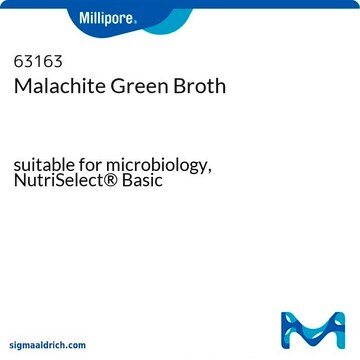M9015
Malachite Green oxalate salt
Dye content, ≥90%, certified by the Biological Stain Commission, powder or crystals
Synonyme(s) :
N,N,N′,N′-tétraméthyl-4,4′-diaminotriphénylcarbenium oxalate
About This Item
Produits recommandés
product name
Malachite Green oxalate salt, certified by the Biological Stain Commission
Qualité
certified by the Biological Stain Commission
Forme
powder or crystals
Composition
Dye content, ≥90%
Couleur
faint green to very dark green
Pf
144-150 °C
Solubilité
H2O: 1 mg/mL, blue to very deep blue
Application(s)
diagnostic assay manufacturing
hematology
histology
Température de stockage
room temp
Chaîne SMILES
C[N+](C)=C1C=CC(C=C1)=C(C2=CC=C(N(C)C)C=C2)C3=CC=CC=C3.[O-]C(C(O)=O)=O
InChI
1S/C23H25N2.C2H2O4/c1-24(2)21-14-10-19(11-15-21)23(18-8-6-5-7-9-18)20-12-16-22(17-13-20)25(3)4;3-1(4)2(5)6/h5-17H,1-4H3;(H,3,4)(H,5,6)/q+1;/p-1
Clé InChI
REZFCYOVFCJTDG-UHFFFAOYSA-M
Vous recherchez des produits similaires ? Visite Guide de comparaison des produits
Description générale
Application
- in the preparation of Alexander staining solution for cell viability test
- in malachite green-ammonium molybdate assay for determining the adenosine triphosphatase (ATPase) activity of binding immunoglobulin protein (BiP)
- as a hydrophobic ion, to study the label-free molecular transport in the living cell membranes of Escherichia coli in real time by second-harmonic generation (SHG) method
Adéquation
Autres remarques
927.00 g/mol - the mass of 2 mol malachite green + 2 mol monohydrogen oxalate + 1 mol dihydrogen oxalate, or
463.50 g/mol - the mass of 1 mol malachite green + 1 mol monohydrogen oxalate + 0.5 mol dihydrogen oxalate
Mention d'avertissement
Danger
Mentions de danger
Conseils de prudence
Classification des risques
Acute Tox. 3 Oral - Aquatic Acute 1 - Aquatic Chronic 1 - Eye Dam. 1 - Repr. 2
Code de la classe de stockage
6.1C - Combustible acute toxic Cat.3 / toxic compounds or compounds which causing chronic effects
Classe de danger pour l'eau (WGK)
WGK 3
Point d'éclair (°F)
Not applicable
Point d'éclair (°C)
Not applicable
Certificats d'analyse (COA)
Recherchez un Certificats d'analyse (COA) en saisissant le numéro de lot du produit. Les numéros de lot figurent sur l'étiquette du produit après les mots "Lot" ou "Batch".
Déjà en possession de ce produit ?
Retrouvez la documentation relative aux produits que vous avez récemment achetés dans la Bibliothèque de documents.
Les clients ont également consulté
Notre équipe de scientifiques dispose d'une expérience dans tous les secteurs de la recherche, notamment en sciences de la vie, science des matériaux, synthèse chimique, chromatographie, analyse et dans de nombreux autres domaines..
Contacter notre Service technique










